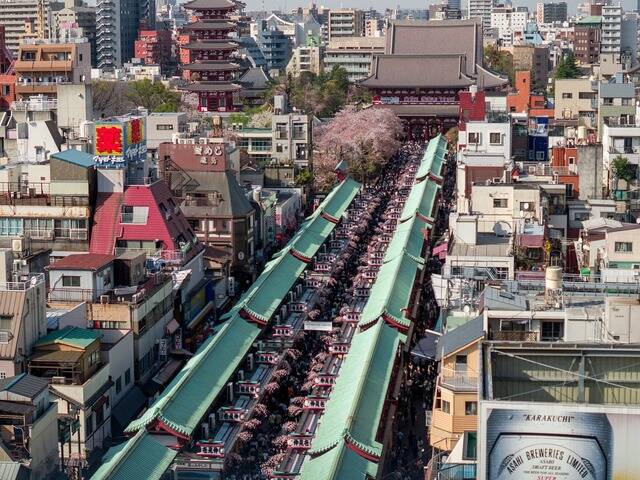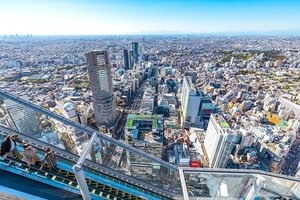The highlights of the general plan for Muslims include visiting Kaminarimon, Nakamise Shotengai, Senso-ji Temple, and Asakusa Shrine in Asakusa; having lunch at a Halal-certified restaurant; visiting Shibuya’s "Five-Way Scramble Crossing"; strolling on shopping streets in Harajuku; and also visiting the largest mosque in Japan, the Tokyo Mosque. Note: Here, we introduce sightseeing tours that are accommodating to Muslims. However, you should know that there are numerous private and personalized excursions that are offered and that, depending on your preferences, some of them may be more suitable. If you want complete flexibility and control over your itinerary, you also have the option to request a customized tour that is designed according to your preferences and needs. Visiting AsakusaThe tour starts when the tour guide from the company meets you at your hotel. First you visit Asakusa, a district on the banks of the Sumida River that is referred to as Shitamachi "Downtown" where the atmosphere of Tokyo of past decades survives. Here you will have your photo taken, a commemorative photo in front of Kaminarimon's "Thunder Gate". Afterward, you can enjoy some shopping and treats along Nakamise Shotengai, "Nakamise Shopping Street". Here, shops provide temple visitors with a variety of local specialties and the usual array of tourist souvenirs. Kaminarimon is the outer of two large entrance gates that leads to the Senso-ji, the inner gate being the Hozomon "Treasure House Gate". You will explore the Senso-ji Temple and Asakusa Shrine before taking a break for lunch at a Halal-certified ramen or sushi restaurant in Asakusa. Visiting ShibuyaIn the afternoon, you will travel about 35 minutes to Shibuya by subway to experience the famous scramble intersection. The best place to get oriented is Shibuya’s Hachiko Exit, which opens onto the famous "Five-Way Scramble Crossing" under the giant video screen. The intersection is heavily decorated by neon advertisements and giant video screens, where every few minutes pedestrian lights turn green and a wave of humanity converges in the middle of the five-way intersection before dispersing again in all directions. There, you will have time to take some more commemorative photos. Visiting HarajukuAfter Shibuya, you will travel to the neighboring area of Harajuku to visit the Meiji-jingu Shrine. On summer weekends, you have a very good chance of catching a Japanese wedding in progress here. From the shrine, you walk a short distance first to Takeshita Street and then over to Omotesando. Omotesando caters to those with more adult or, at least, more expensive tastes. The neighborhood has many large international chain stores, with high-end luxury merchandisers extensively represented along Omotesando. For teenagers, the place to be is Takeshita Street, which is a bustling, narrow street that has become a symbol for the teen culture of Harajuku and is extremely crowded on weekends. To finish the day, you will visit the largest mosque in Japan. Tokyo Mosque also known as Tokyo Camii, was founded in 1938, and rebuilt in 2000, following Ottoman architectural style. It is both a religious venue and an ethnocultural space, hosting wedding ceremonies, fashion shows, plays, exhibitions, and conferences. In recent years, it has also become a tourist attraction for both Muslims and non-Muslim tourists visiting Tokyo. Below, there are three Tokyo private guided tours with almost the same content. To see the availability, price, and what is included, click on the image or the link in the description below. One Day Tokyo Halal Tour
39 Comments
Shamima
4/2/2023 20:12:08
Slms,
Reply
Halal In Japan
4/3/2023 10:26:48
We will send you an email.
Reply
6/3/2023 09:56:20
Salam
Reply
Halal In Japan
6/3/2023 18:13:11
We will reply to you by email.
Reply
Habsliza Suhaili
7/10/2023 18:56:39
Salam,
Reply
Halal In Japan
7/11/2023 10:12:49
We will contact you by email.
Reply
Anita Ayat
7/15/2023 19:40:34
Salam,
Reply
Halal In Japan
7/15/2023 20:15:16
We contact you by email.
Reply
Sha
8/5/2023 23:09:55
Salam.
Reply
Halal In Japan
8/6/2023 19:51:18
I will send you an email.
Reply
sharif e
8/14/2023 13:43:52
we are a family of 5-6 planning to visit japan in early december
Reply
Halal In Japan
8/14/2023 20:38:19
We will send you an email!
Reply
9/4/2023 11:53:47
To Request A Customized Tour: In the website footer below, under "Top Destination", click on the "Customize Your Tour" link and provide the required information.
Reply
9/11/2023 10:30:26
Thank you for filling out the tour request form. You will receive an email shortly.
Reply
hannah
10/5/2023 11:27:41
Hi,
Reply
Suhail
10/17/2023 01:47:28
Hello, we will be visiting Tokyo this Wednesday Oct/18th. We are looking to explore Tokyo and Mt Fuji and also some other cities. We are heading back on the 24th so I would love it if you can tailor an itinerary that is halal friendly for us. It will just be for two person, my wife and I.
Reply
E
10/26/2023 12:14:11
Hi. Looking for halal tour end nov planning to visit mt fuji, ropeway and gpo. For adults and 1 kid. Pls pm for info
Reply
Radziah
11/3/2023 10:15:28
I'm looking for tourist guide to visit tokyo on the 11/15/2023
Reply
Halal In Japan
11/3/2023 18:07:09
You will receive an email shortly..-
Reply
Begum
11/5/2023 03:00:19
My daughter and I will be in Tokyo from 6 to 9 Dec.
Reply
Halal In Japan
11/5/2023 10:37:07
You will receive an email shortly.._
Reply
Fadli dzul
12/27/2023 05:10:18
Hi im going to tokyo on 27th feb - 4 march. Need a day tour to mt fuji ropeway and gpo. Will be going with total of 6 adult, 1 kid and two infants. Am looking for halal tour. Kindly suggest your package. Thank you
Reply
Rafi
1/13/2024 00:04:07
We are family of 3 and planning to go in November / December period. I am looking for halal tour. Do suggest ur package.
Reply
Nadia
2/15/2024 00:21:13
Interested in this your. Could I get more details with pricing.
Reply
Halal In Japan
2/15/2024 10:15:10
You will receive an email shortly..!
Reply
Rosilah Hussein
5/27/2024 21:56:14
Possible to recommend a mustlim tour guide for a day trip outside Tokyo fm Shinjuku
Reply
Halal In Japan
5/28/2024 09:27:21
We will send you an email-
Reply
MUHAMMAD ADNAN ZIA
6/14/2024 18:57:37
Salam
Reply
Halal In Japan
6/14/2024 22:48:39
You will receive an email shortly!!
Reply
Adnan
6/22/2024 05:09:58
How can we book
Reply
Halal In Japan
6/22/2024 10:42:33
There are three images at the bottom of the page. Please click on the images or the links (See complete details) provided. You will be redirected to the Viator website, where you will see the complete details of the tour. You can check the availability for your selected date and do the booking online.
Reply
Khurram
7/24/2024 03:23:07
I am visiting for 5 days in Tokyo & 5 days in Kyoto.
Reply
Halal In Japan
7/24/2024 10:08:31
We will contact you by email
Reply
Leave a Reply. |
Halal In Japan
|
|







 RSS Feed
RSS Feed





